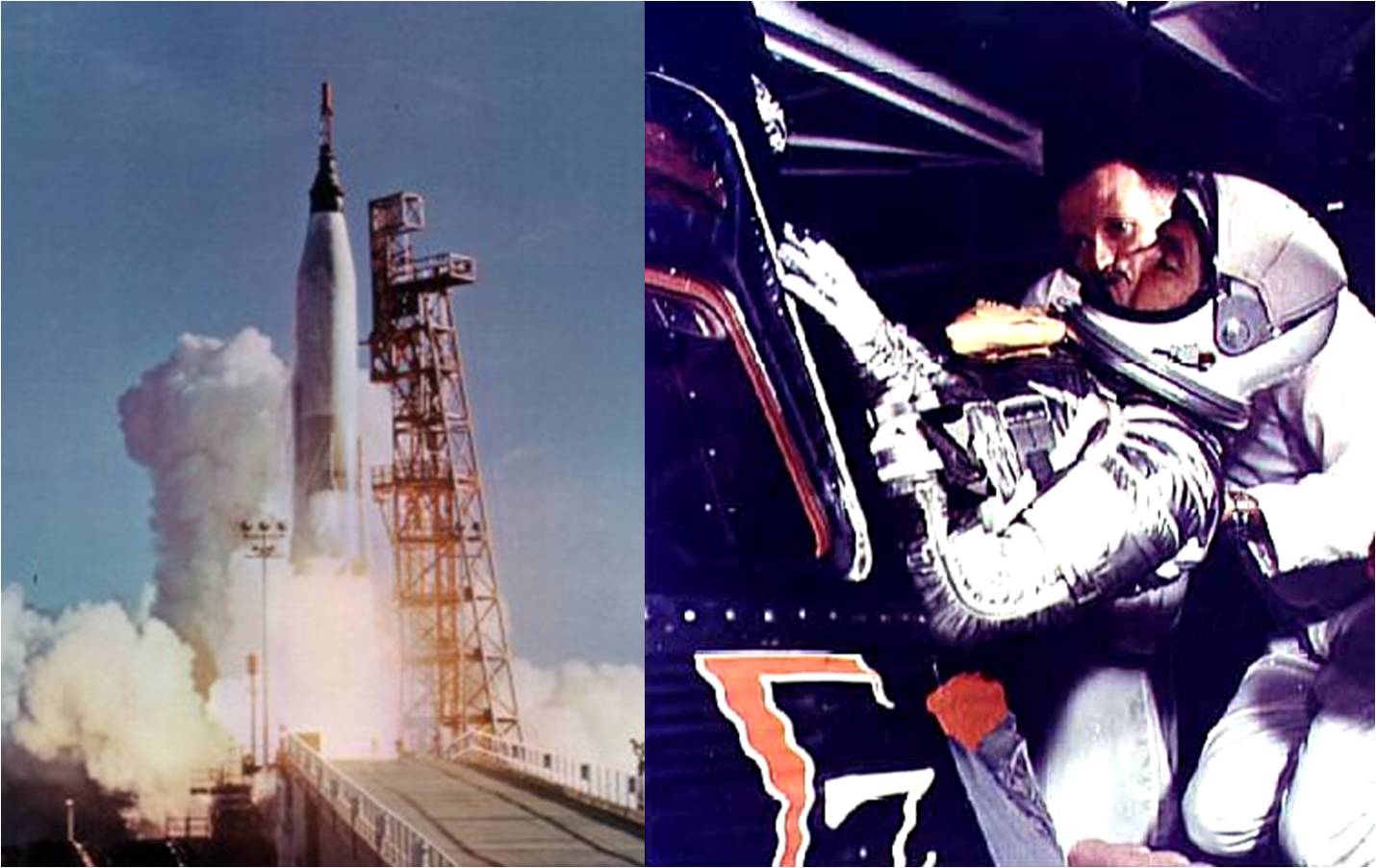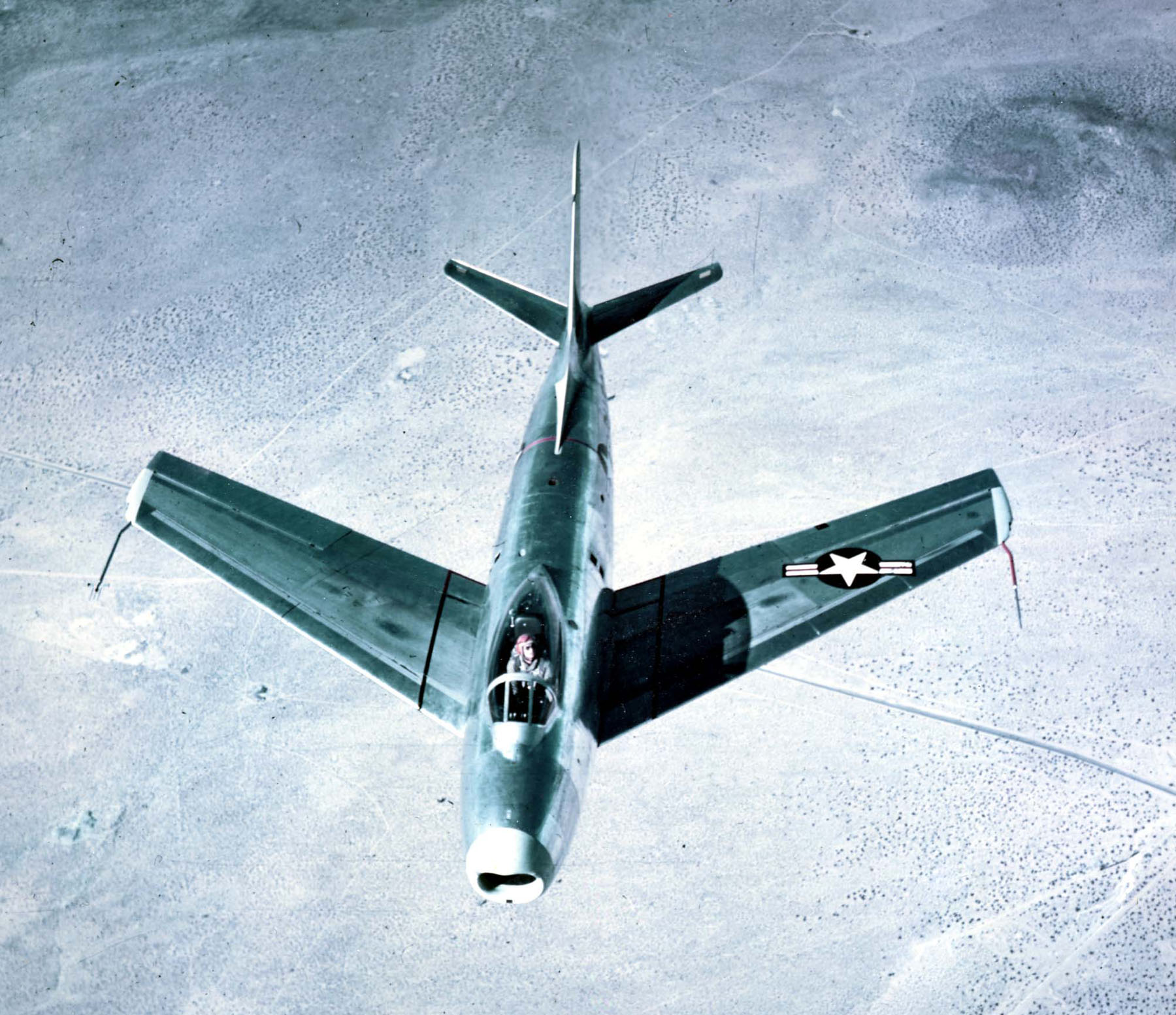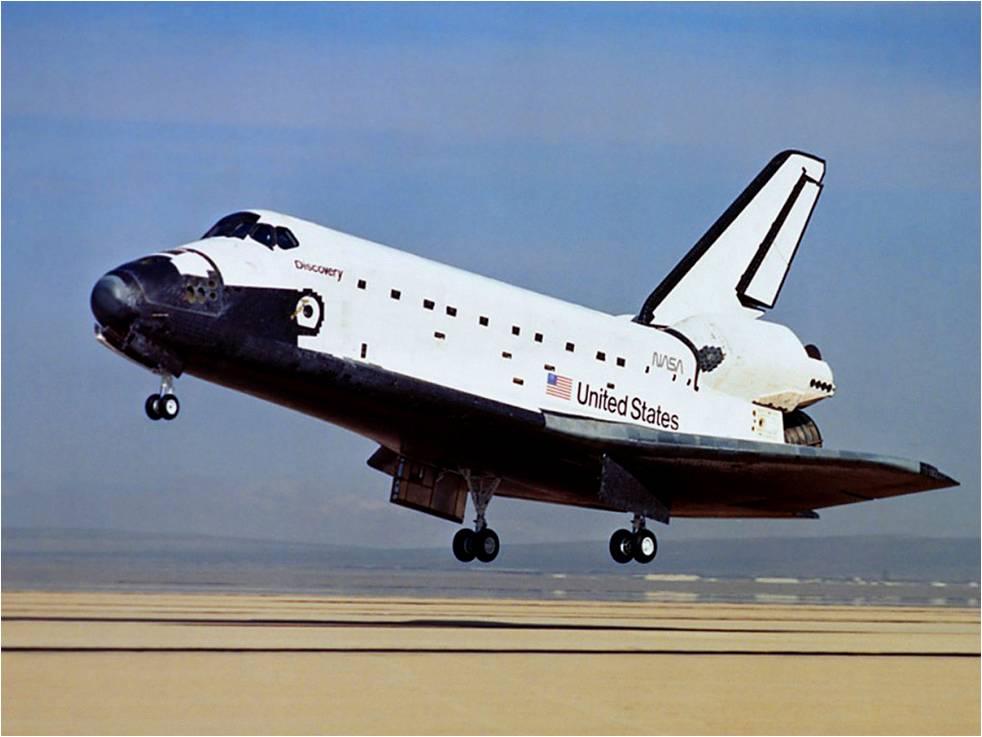
Forty-eight years ago this month, Mercury Astronaut Walter M. Schirra, Jr. orbited the Earth six (6) times in his Mercury spacecraft code-named Sigma 7. The near-perfect 9-hour spaceflight was the United States’ third manned orbital mission flown within a period of eight (8) months.
Project Mercury was United States’ first manned spaceflight program. This historic pioneering space effort helped lay the foundation for America’s quest for the Moon. A total of six (6) missions (2 sub-orbital and 4 orbital) was flown between May of 1961 and May of 1963.
The Mercury Spacecraft measured 11.5 feet in length and had a diameter of 6.2 feet. Orbital weight was roughly 3,000 pounds. With a cockpit volume of only 60 cubic feet, an astronaut’s corporeal fit inside the spacecraft was exceedingly tight. Vehicle entry and egress was a real shoe-horning process. It is not complete hyperbole to say that, once inside, an astronaut wore, more than rode in, the Mercury space vehicle.
Despite its dimunitive size, the Mercury Spacecraft was an able spacefaring ship. Indeed, it was configured with a complete suite of life support, navigation, attitude control, communications, deboost, recovery and thermal protection systems. Aided by a vast national mission support team, recovery force, and world-wide tracking system, the Mercury spaceflight effort was entirely successful in establishing America in space.
America’s first astronauts were known as the Mercury Seven. History records their names; Shepard, Grissom, Glenn, Carpenter, Schirra, Cooper and Slayton. In the tense 1960’s Space Race with the Soviet Union, these men were indeed America’s Single-Combat Warriors immortalized by writer Tom Wolfe in his classic, The Right Stuff.
Mercury-Atlas No. 8 (MA-8) was the fifth Mercury mission. Whereas the two (2) previous flights had been three (3) orbit missions, MA-8 was scheduled to orbit the Earth six (6) times. The focus would be on spacecraft operations instead of space science. The intent was to verify that the Mercury spacecraft could be cleared for an orbital mission duration of at least 24 hours on the very next flight
As was the custom for a Mercury astronaut, Schirra personally named his orbital steed. As such, Schirra chose the name Sigma 7. The term Sigma, the Greek mathematical symbol for summation, signified a summation or culmination of flight experience and engineering development that led to a mature Mercury Spacecraft system. The numeral 7 represented the Mercury Seven.
The MA-8 mission began with lift-off from Cape Canaveral’s LC-14 at 12:15:12 UTC on Wednesday, 03 October 1962. The Atlas D launch vehicle placed Schirra into a 152.8-nm x 86.9-nm orbit. Once in orbit, Schirra quickly got down to business. This included tracking the Atlas booster, maneuvering the spacecraft, observing and photographing the Earth, and conducting various scientific experiments.
Schirra did a particularly good job at conserving the precious supply of Reaction Control System (RCS) fuel. One of the MA-8 objectives had been to do so. In fact, Schirra conserved fuel even more efficiently than planned. Other than an annoying and uncomfortable spacesuit heating problem that occurred several times, the entire MA-8 mission was what Schirra would ultimately call “textbook”.
MA-8 retro-fire occurred at 21:07:12 UTC. During the reentry, the automatic rate stabilization system damped spacecraft pitch and yaw oscillations. Drogue and main parachute deployment took place at 40,000 feet and 15,000 feet, respectively. Splashdown in the Pacific Ocean occurred 1,200 nm northwest of Hawaii at 21:28:22 UTC.
The success of MA-8 paved the way to Gordon Cooper’s historic 22-orbit, 34-hour MA-9 mission in May of 1963. The Gemini and Apollo Programs would soon follow. Wally Schirra would play a big part in both. He commanded the historic Gemini 6 orbital rendezvous mission in December of 1965. Schirra also went on to command the critical Apollo 7 mission in October of 1968.
Wally Schirra was the only member of the Mercury Seven to orbit the Earth in Mercury, Gemini and Apollo spacecraft.

Forty-five years ago this month, the USAF/North American XB-70A Valkyrie reached three times the speed of sound for the first time. The historic aviation achievement took place on the 18th anniversary of the breaking of the sound barrier by the USAF/Bell XS-1.
When it comes to legendary aircraft, aviation enthusiasts speak in almost reverent terms about the XB-70A Valkyrie. Indeed, few aircraft have evoked such utter awe or symbolized better the profound majesty of flight than the “The Great White Bird”. Though its flight history was brief, the XB-70A’s influence on aviation has proven to be of enduring worth.
The Valkyrie measured 185 feet in length, had a wingspan of 105 feet and an empty weight of 210,000 pounds. With a GTOW of 550,000 pounds, it was the heaviest supersonic-capable aircraft of all-time. The aircraft was powered by a six-pack of General Electric YJ93-GE-3 turbojets totaling 172,200 pounds of thrust in afterburner.
To enhance lift-to-drag ratio and directional stability at high Mach number, the Valkyrie was configured with wing tips that could be deflected downward as much as 65 degrees. Each wing tip was the size of an USAF/Convair B-58A Hustler wing panel. To this day, the XB-70A deflectable wing tip is the largest control surface ever used on an aircraft.
The XB-70A was originally intended to be a supersonic strategic bomber. The aircraft’s mission was to penetrate Soviet airspace at Mach 3 and deliver nuclear ordnance from an altitude of 72,000 feet. However, the rapid ascendancy of Soviet surface-to-air missile capability would compromise the type’s military mission before it even flew.
As a consequence of the above, the Valkyrie ultimately became a high-speed flight research aircraft. Only two (2) copies were constructed and flown. Ship No. 1 (S/N 62-0001) made its maiden flight on Monday, 21 September 1964 while Ship No. 2 (62-0207) first took to the air on Saturday, 17 July 1965.
XB-70A Ship No. 1 became the first Valkyrie to hit Mach 3. It did so while flying at an altitude of 70,000 feet on Thursday, 14 October 1965. The flight crew consisted of North American Aviation test pilot Alvin S. White (aircraft commander) and USAF Colonel Joseph Cotton (co-pilot).
The XB-70A aircraft flew all of their flight research missions out of Edwards Air Force Base in California. Between September of 1964 and February of 1969, a total of 129 XB-70A research flights took places; 83 by Ship No. 1 and 46 by Ship No. 2. A total of nearly 253 flight hours was amassed by the aircraft.
The XB-70A Program made significant contributions to high-speed aircraft technology including aerodynamics, aerodynamic heating, flight controls, structures, materials, and air-breathing propulsion. Lessons-learned from its flight research have been applied to numerous aircraft developments including the B-1A, American SST, Concorde and the TU-144.
XB-70A Ship No. 1 survived the flight test program while Ship No. 2 did not. The latter was destroyed in a mid-air collision with a NASA F-104N on Wednesday, 08 June 1966. Today, XB-70A Ship No. 1 can be seen at the National Museum of the United States Air Force at Wright-Patterson Air Force Base in Dayton, Ohio.

Sixty-three years ago this month, the swept-wing XP-86, the initial version of the famed USAF/North America F-86 Sabre, began flight testing at what is now Edwards Air Force Base. The popular Mig Alley legend would be produced in numerous variants and ultimately rack-up a total production run of nearly 10,000 aircraft worldwide.
In the waning days of World War II, the United States Army Air Force (USAAF) issued the requirements for a new high-speed, jet-powered fighter/interceptor aircraft. North American Aviation (NAA) captured the USAAF’s attention with a prototype swept-wing aircraft known as the XP-86. The “X” designation was shorthand for Experimental while the “P” stood for Pursuit.
The XP-86 (later designated as the XF-86 where “F” stood for Fighter) was the first United States fighter to incorporate wing sweep. The key benefit derived from sweeping the wings was to greatly reduce transonic wave drag. Based on aerodynamics data captured from the defeated Third Reich, NAA engineers designed the XF-86 with a wing sweep of 35 degrees.
A drawback to using wing sweep is that low-speed flight characteristics are adversely affected. The principal detrimental effect being a reduction in lift. However, NAA solved this problem by the incorporation of leading edge slats to enhance lift production at low speed.
The XF-86 measured roughly 37-feet both in length and wingspan. Empty weight was some 12,000 lbs. Power was provided by a Chevrolet J35-C-3 turbojet that generated a paltry 3,750 pounds of thrust. Later variants of the Sabre would be powered by jet engines generating nearly 10,000 pounds of thrust.
On Wednesday, 01 October 1947, XF-86 No. 1 took to the air for the first time from Muroc Army Air Field, California. USAAF Major and WW II 16-kill ace George S. “Wheaties” Welch was at the controls of the XF-86. Intestingly, the historical record strongly suggests that Welch exceeded the speed of sound during a dive on that first flight test.
The case of George Welch is an intriguing sub-plot of the F-86 Sabre story. Welch was stationed at Pearl Harbor on 07 December 1941. He was one of the very few American pilots to get in the air and fight the attacking Japanese forces. Numerically overwhelmed, he nontheless splashed four (4) enemy aircraft and lived to fly and fight another day.
Welch served three (3) combat tours in WW II for a total of 348 combat missions. After leaving the service in 1944, he joined North American Aviation as a test pilot. Welch progressed quickly and became NAA’s Chief Test Pilot. This path ultimately led to Welch flight testing the XP-86 Sabre.
Although denied verification in official Air Force records, both oral history and strong circumstantial evidence points to the high likelihood that Welch exceeded Mach 1 at least twice before the Bell XS-1 did so on Tuesday, 14 October 1947.
Incredibly, the first instance of Welch and the XF-86 exceeding Mach 1 was on the occasion of its first flight test! Welch dove the aircraft from 35,000 feet and reportedly generated a weak sonic boom.
The second instance of Mach 1 exceedance reportedly occurred on Tuesday, 14 October 1947. This time Welch dove the XF-86 from 37,000 feet and generated a stronger sonic boom. Apparently, this event took place just before the Bell XS-1, with USAAF Major Charles E. “Chuck” Yeager at the controls, achieved Mach 1.06 later that same morning.
Welch was never officially credited with being the first to achieve supesonic flight. A number of reasons account for this circumstance. First, his aircraft was not instrumented properly to verify flight performance at quasi-supersonic speeds. Additionally, Welch’s aircraft was not tracked by radar.
In addition to the technical reasons cited above, there was political intrigue surrounding Welch’s supersonic dive flights as well. NAA (and thus Welch) had been ordered not to exceed Mach 1 before the rocket-powered Bell XS-1 did so. Perhaps the only concession accorded Welch was that USAF later referred to Yeager’s historic superonic flight as the first time the sound barrier was broken in level flight.
George Welch went on to a distinguished, but all too brief flight test career. On Monday, 25 May 1953, he became the first man to exceed Mach 1 in level flight in a jet-powered production aircraft. That aircraft was the North American F-100 Super Sabre. Welch perished on Tuesday, 12 October 1954 when his YF-100A went out of control and distintegrated during a 7-g pull-up at Mach 1.55.
For its part, the F-86 Sabre ultimately served long and well in the air forces of the United States and a host of other western-friendly nations. Perhaps its greatest claim to fame accrues from the type’s remarkable aerial combat perfromance in the Korean War. Indeed, despite being numerically bested by Soviet-built MIG-15 aircraft, the official record shows that USAF pilots made 792 kills flying the Sabre. Compared with 76 kills made by the opposition, the Sabre registered a phenomenal 10:1 kill ratio.

Twenty-two years ago this week, the Space Shuttle Discovery and its five man crew landed on Rogers Dry Lake at Edwards Air Force Base to successfully complete the Return-to-Flight (RTF) mission of STS-26. The flight signaled a resumption of the Space Shuttle Program after a 32-month hiatus in manned spaceflight resulting from the Challenger disaster.
Well chronicled is the tragic loss of the Space Shuttle Challenger and its crew of seven on Tuesday, 28 January 1986. Following lift-off at 16:38 UTC from Cape Canaveral’s LC-39B, the launch vehicle distintegrated 73 seconds into flight. The presidentially-appointed Rogers Commission concluded that the primary cause was failure of an O-ring seal in a field joint of the right Solid Rocket Booster (SRB).
While the SRB O-ring failure was the physical cause of the Challenger mishap, the Rogers Commission brought to light a more fundamental and disturbing reason for the tragedy. Specifically, the very decision to launch Challenger on that unusally cold January morning in Florida was fundamentally flawed.
As chillingly delineated in Dianne Vaughan’s “The Challenger Launch Decision”, a culture of deviance with respect to Shuttle flight safety issues had slowly developed at NASA. Pressure to launch, scarce resources and organizational disconnects contributed to NASA management’s blind spot when it came to Shuttle flight safety. The SRB contractor was culpable as well and for the same reasons.
Following redesign and testing of the SRB field joints and the implementation of a myriad of other fixes, NASA prepared to return the Shuttle to flight. The mission was designated as STS-26. To the Space Shuttle Discovery would go the honor of and the responsibility for flying the RTF mission. STS-26 was to be a five day orbital mission.
A five-member crew was selected by NASA to fly STS-26. Each crew member had spaceflight experience. You remember their names. Mission Commander Frederick H. “Rick” Hauck, Pilot Richard O. Covey, and Mission Specialists John M. “Mike” Lounge, George D. “Pinky” Nelson and David C. Hilmers.
Discovery and her brave crew lifted-off from at 15:37 UTC on Thursday, 29 September 1988 from the very same location that Challenger did; LC-39B at Cape Canaveral, Florida. Millions watched that day. Some were in the big crowds that formed in and around the Cape complex. Most observed the event on television. Many prayed.
All who watched Discovery lift-off that day remembered the previous Shuttle flight. Indeed, they remembered what happened just after the CAPCOM’s call: “Challenger, go at throttle-up.” (Ironically, Richard Covey was the CAPCOM who made that very call.) Today, they heard a similar call over the Shuttle communications network: “Discovery, go at throttle-up.” A collective breath was held. After throttle-up, Discovery continued all the way to orbit. YES!!!
The mission itself seemed to be anti-climatic. A Tracking and Data Relay Satellite (TDRS) was deployed from Discovery’s payload bay to replace the one lost in the Challenger explosion. A multitude of space experiments was conducted by the crew. Fairly standard stuff. Only deboost, the rigors of reentry and the typical dead-stick landing lay ahead.
Discovery landed on Runway 17 at Edwards Air Force Base on Monday, 03 October 1988. Main gear touchdown occurred at 16:37 UTC. Approximately, 450,000 American’s witnessed Discovery’s landing in person. A few who did had witnessed its launch in person as well.
The emotion that attended Discovery’s landing in October 1988 was simply overwhelming. Indeed, the experience was an integral part of the healing process for a Nation that still grieved the loss of Challenger and her crew. A Time magazine cover page headline the following week excitedly read: “Whew! America Returns to Space” And indeed it had.




